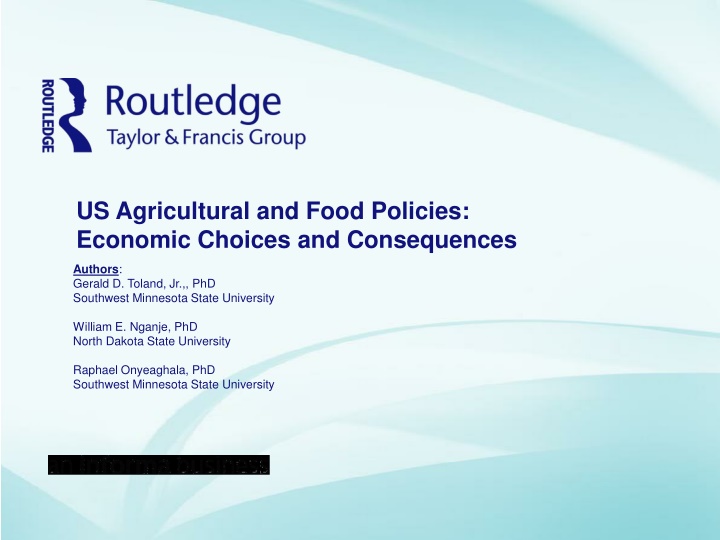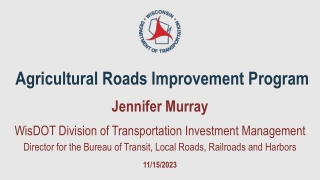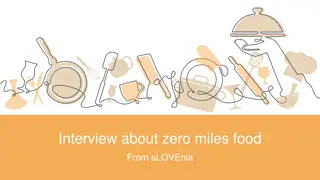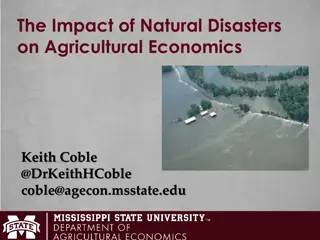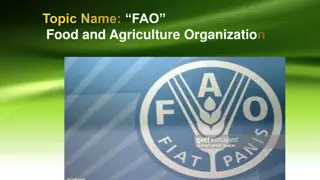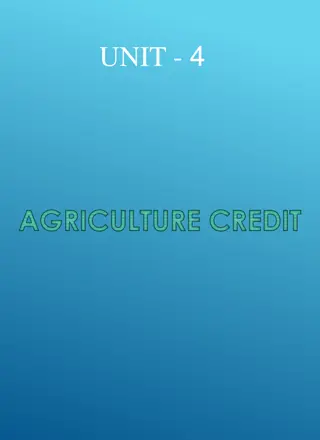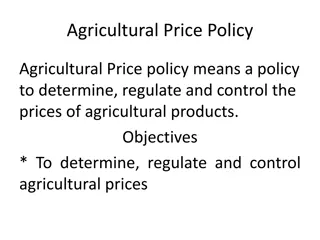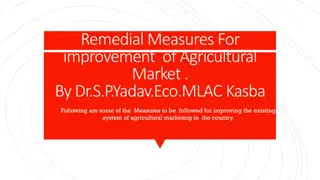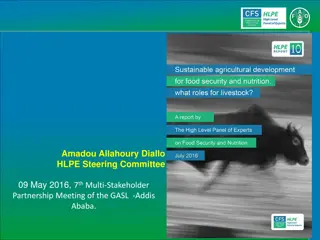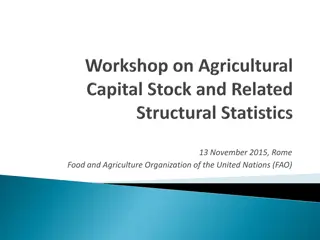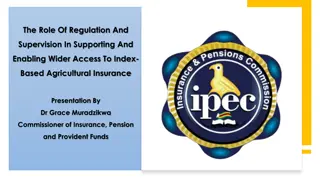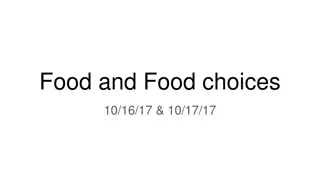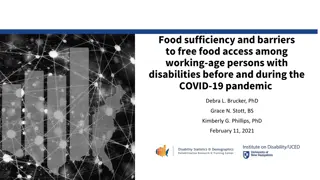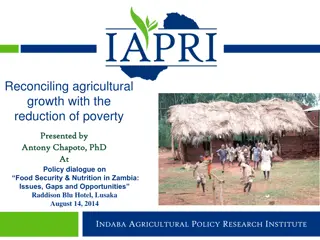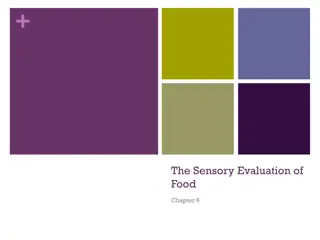Economic Choices and Consequences in US Agricultural and Food Policies
This book delves into the multi-dimensional aspects of food security, exploring relationships between household food security and agri-food systems, addressing food insecurity challenges, and proposing solutions through food hubs and institutional innovations. It discusses how local agri-food systems, regional food networks, and public-private partnerships can establish sustainable food-secure conditions globally.
Download Presentation

Please find below an Image/Link to download the presentation.
The content on the website is provided AS IS for your information and personal use only. It may not be sold, licensed, or shared on other websites without obtaining consent from the author.If you encounter any issues during the download, it is possible that the publisher has removed the file from their server.
You are allowed to download the files provided on this website for personal or commercial use, subject to the condition that they are used lawfully. All files are the property of their respective owners.
The content on the website is provided AS IS for your information and personal use only. It may not be sold, licensed, or shared on other websites without obtaining consent from the author.
E N D
Presentation Transcript
US Agricultural and Food Policies: Economic Choices and Consequences Authors: Gerald D. Toland, Jr.,, PhD Southwest Minnesota State University William E. Nganje, PhD North Dakota State University Raphael Onyeaghala, PhD Southwest Minnesota State University
US Agricultural and Food Policies: Economic Choices and Consequences Chapter 10 - Exploring the Multi-Dimensional Aspects of Food Security Chapter Ten Objectives Chapter Ten is an introduction to some of the important questions and policies associated with the wide-ranging topic of food security policy. The organization of the chapter is straightforward: We examine methods and criteria used to define food-secure and food-insecure households. We review key aspects of United States food security policy. We follow-up our overview of US food security policy by studying multi-national and global efforts to improve nutritional conditions for households worldwide. 2
US Agricultural and Food Policies: Economic Choices and Consequences Chapter 10 - Exploring the Multi-Dimensional Aspects of Food Security Chapter Ten Objectives (Continued) We observe relationships between household food security and the operational effectiveness of our agri-food systems: We study the food security problems associated with geographic areas classified as food deserts . We review the dynamic new role of food hubs in achieving efficient and equitable food distributional outcomes. We study how food hubs and related institutional innovations may offer solutions for areas experiencing food insecurity challenges. Finally, we examine how local agri-food systems, regional food networks and public-private partnerships can help communities establish sustainable food-secure conditions. 3
US Agricultural and Food Policies: Economic Choices and Consequences Chapter 10 - Exploring the Multi-Dimensional Aspects of Food Security Challenges of Food Insecurity Can we alleviate poverty and help create a world where households are more food secure? The United Nations (UN), the G8 and G20 Alliances, the US Agency for International Development (USAID) and the USDA reached a near-consensus around one policy theme*: Coordinating local, regional and global policies to create a world where every household is food secure. The ultimate policy goal is to encourage global economic progress, and consequently increase the likelihood that every household can access a nutritional diet. *G8 L Aquila Summit. L Aquila Joint Statement on Food Security L Aquila Food Security Initiative. L Aquila, Italy: July 10, 2009. Retrieved from: https://feedthefuture.gov/sites/default/files/resource/files/afsi_jointstatement_2009.pdf 4
US Agricultural and Food Policies: Economic Choices and Consequences Chapter 10 - Exploring the Multi-Dimensional Aspects of Food Security Definition and Dimensions of Food Security Naylor (2014) defines food security as: Food Security means having adequate supplies of affordable food throughout the year to ensure a healthy and productive life. Headey and Ecker (2013) and Naylor (2014) recommend four dimensions to assess conditions as food secure or insecure: Availability (Food supply adequacy) Access (Sufficient income to purchase food) Utilization (Are diets nutritionally balanced?) Stability (Can households sustain food access as markets, politics and climate fluctuate?) 5
US Agricultural and Food Policies: Economic Choices and Consequences Chapter 10 - Exploring the Multi-Dimensional Aspects of Food Security USDA developed a four-stage security continuum to gauge different levels: High Food Security Marginal Food Security Low Food Security Very Low Food Security USDA taxonomy: Food secure households have no problems accessing food (high food security), or have periodic problems with food access (marginal food security). Low food secure households have reduced economic access to balanced nutritional diets. Very low food security causes households to experience real diet disruptions. Food Secure Households Food Insecure Households 6
US Agricultural and Food Policies: Economic Choices and Consequences Chapter 10 - Exploring the Multi-Dimensional Aspects of Food Security United Nations (UN) Focused on Improved Food Security as part of overall Global Progress UN identified eight Millennium Development Goals (MDG s) The UN s first MDG: Eradicate Extreme Poverty and Hunger Clear connection between extreme poverty and food insecurity. Naylor (2014): One-third of global population households earning less than $1.25 per day). Impoverished households susceptible to food insecurity and chronic hunger whenever food prices rise or average incomes fall. 7
US Agricultural and Food Policies: Economic Choices and Consequences Chapter 10 - Exploring the Multi-Dimensional Aspects of Food Security Food Insecurity in the United States ERS Study: Food-insecure US households were 12.7% in 2015; less than the 14.9% level in 2011. In 2011, the US was still recovering from the 2008-2009 Great Recession. Improved food security is negatively correlated with unemployment. As household income rises and unemployment falls, we expect households to become more food secure. Gunderson, Kreider and Pepper [GKP] (2011) determined that households classified as very low food secure are less responsive to better income and employment conditions; Need to study effects of other factors on ways to increase food security. GKP also note 65% of households at the Poverty Line were food secure, while 20% of households above the line were food insecure. More research is needed. 8
US Agricultural and Food Policies: Economic Choices and Consequences Chapter 10 - Exploring the Multi-Dimensional Aspects of Food Security US Food Safety Net and Household Food Security GKP [2011] determined that participation in Supplemental Nutrition Assistance Program (SNAP) and the National School Lunch Program (NSLP)) measurably reduced household food insecurity. GKP also concluded that food insecure households experience more frequent birth defects, anemia, cognitive disabilities, depression and increased instances of chronic disease and long-term physical health problems. Programs (e.g., SNAP and NSLP) can reduce national health care costs by improving household food security. 9
US Agricultural and Food Policies: Economic Choices and Consequences Chapter 10 - Exploring the Multi-Dimensional Aspects of Food Security Linkages between US and Global Food Security Initiatives GKP (2011) cite an 18-question survey, known as the Core Food Security Module (CFSM). The CFSM is a common measurement instrument that can be used to make comparisons of household food security determinations across different nations. The CFSM is one tool to support basic research on how to make global gains in household food security. In addition to research, the US-initiated Feed the Future program provides coordination and financial support from eleven different US federal agencies to increase household food security worldwide. The US Feed the Future program utilizes international guidelines known as the Rome Principles. See the next slide. 10
US Agricultural and Food Policies: Economic Choices and Consequences Chapter 10 - Exploring the Multi-Dimensional Aspects of Food Security US Feed the Future initiative is based on five Rome Principles: Each nation develops a country-owned plan to reduce food insecurity. Coordinate private, public and non-government organizational efforts to maximize impact and prevent unnecessary overlap. Encourage the development and implementation of plans that are comprehensive in their design. Leverage the strengths of multilateral institutions to achieve the necessary size and combination of financial, technological, and human resources to reach desired results. Use realizable and substantial benchmarks to set achievable and sustainable food security goals. 11
US Agricultural and Food Policies: Economic Choices and Consequences Chapter 10 - Exploring the Multi-Dimensional Aspects of Food Security The Global Food Security Act (GFSA) of 2016: Sustains the Feed the Future initiative GFSA requires accountability and transparency for operating and funding the Feed the Future program Through the US Agency for International Development (USAID), the GFSA requires the President to coordinate agencies, establish monitoring and evaluation systems, and create platforms for consultation with stakeholders and Congressional committees. GFSA aims to enhance global food security by helping developing nations to help themselves . The GFSA funds Feed the Future initiative that increase their agricultural production and distribution capacity. Nations can make progress towards self-sufficiency. 12
US Agricultural and Food Policies: Economic Choices and Consequences Chapter 10 - Exploring the Multi-Dimensional Aspects of Food Security Global Food Insecurity Condition UN s Food and Agriculture Organization (FAO), the International Fund for Agricultural Development (IFAD) and the World Food Programme (WFP) jointly publish an annual report: The State of Food Insecurity in the World (SFIW). 2015 SFIW: Food insecure households in 2015 were 12.9% of global population. In 1990-1992, food insecure households stood at 23.3% 72 of 129 monitored countries (56%) had achieved the Millennium Development Goal (MDG) of reducing the rate of malnutrition by half. Progress, but 795M households worldwide remain food insecure. 13
US Agricultural and Food Policies: Economic Choices and Consequences Chapter 10 - Exploring the Multi-Dimensional Aspects of Food Security Economic Modeling Projections of future global food security conditions USDA s ERS performed economic modeling to make future projections of food availability in developing countries since the 1970 s. In 2016, the research has become known as the International Food Security Assessment (IFSA). Results of the IFSA, 2016-2026: IFSA model projections: future 10-year market growth patterns produce lower food prices and rising household incomes. Encouraging IFSA forecast: Food insecure households in 76 developing nations will decrease from 17% in 2016 to 6% in 2026. IFSA Limitations Gauge average calorie intake, not broader nutrition status. Upbeat IFSA - making a difference in future conditions is achievable. 14
US Agricultural and Food Policies: Economic Choices and Consequences Chapter 10 - Exploring the Multi-Dimensional Aspects of Food Security Relationships between Food Security and Food Systems Broad perspective: Consider food insecurity status in relation to food access options that are both nutritious and reasonably priced. Food security implies access to a well-rounded diet. In the US, some rural (and urban) households have more accessto convenience stores and fast food outlets than to supermarkets (where a wider selection of nutritious foods are available at relatively affordable prices). The 2008 Farm Bill defines a food desert : A food desert is an area in the United States with limited access to affordable and nutritious food, particularly such an area composed of predominantly lower income neighborhoods and communities 15
US Agricultural and Food Policies: Economic Choices and Consequences Chapter 10 - Exploring the Multi-Dimensional Aspects of Food Security Food Deserts: A challenge for food systems to address: 2001 Household Survey: 6% of US households experienced deficiencies of needed or desired foods because access was limited or absent. ERS Study: Food deserts located in areas where 50% of households located in the food desert had less than sufficient income to purchase all needed foods. A Causality Question is in need of research: We do not have the evidence to determine whether income or geographic access is the most significant limitation. We need definitive studies to determine the key constraints. 16
US Agricultural and Food Policies: Economic Choices and Consequences Chapter 10 - Exploring the Multi-Dimensional Aspects of Food Security How to solve problem of Food Deserts and related challenges? ERS: We must determine the root causes of limited access Are there locational diseconomies of scale for private retailers, preventing them from making financial commitments to build and operate a retail outlet in a food desert? Or, do local authorities need to be more responsive to industry requests for lower tax burdens; Or, should local authorities be more flexible about relaxing zoning restrictions? If private interests are not satisfied, they can build outlets outside of food desert areas . Not all property taxes or zoning laws are unreasonable. But, raise the question of how to reduce the public cost burdens within food deserts; create local conditions that are conducive to more nutritious and active food markets. 17
US Agricultural and Food Policies: Economic Choices and Consequences Chapter 10 - Exploring the Multi-Dimensional Aspects of Food Security Food System Innovation Effects on US Household Food Security Changes occurring in US regional and local food systems 2006-2014, the number of farmers markets grew by 180%. Aggregating locally-produced foods, known as regional food hubs , distributed foods to wholesale, retail, institutional and individual buyers. The number of food hubs increased 288% during 2006-2014. Locally-sourced farm-to-school food programs serve educational and nutritional goals. The USDA Farm-to-School Census indicated that 4,322 school districts were operating with these programs in 2014, a 430% increase since 2006. 18
US Agricultural and Food Policies: Economic Choices and Consequences Chapter 10 - Exploring the Multi-Dimensional Aspects of Food Security How to solve problem of Food Deserts and related challenges? (Continued) 2013: Schmit, Jablonski, and Kay [SJK] investigated the economic impacts of a New York State food hub. The NY food hub encouraged farm business expansion. Local farmers also benefitted from increased access local to consumer markets. Households in food deserts could link-up to food hub distribution networks. A range of new and potentially healthier food options could be affordably be made available to food deficient households. 19
US Agricultural and Food Policies: Economic Choices and Consequences Chapter 10 - Exploring the Multi-Dimensional Aspects of Food Security Food System Innovation Effects on US Household Food Security (Continued) Innovative local food systems, such as cooperative Food Hubs, create options to improve US food security. Government agencies and private volunteer organizations have a range of new supply options to increase nutritional food access to nutritional foods. The rapid pace of change in local food systems means that we do not yet know what all the options or possibilities are. More research and experimentation is needed to determine which options are viable. 20
US Agricultural and Food Policies: Economic Choices and Consequences Chapter 10 - Exploring the Multi-Dimensional Aspects of Food Security Private-Public Partnerships, Local Leadership and the Future of Sustainable Food Secure Solutions [SJK] observed that local farmers benefit from the food hub s capacity to access local consumer markets and offer storage options for product delivery. Households located in food deserts could be linked to a food hub distribution network. New and potentially healthier food options could be affordably be made available to food deficient households. AGree: Private sector initiative that receives input from 44 different agri-businesses, farmers, non-profit organizations, volunteer groups, university professors and charitable foundations. 21
US Agricultural and Food Policies: Economic Choices and Consequences Chapter 10 - Exploring the Multi-Dimensional Aspects of Food Security Private-Public Partnerships, Local Leadership and the Future of Sustainable Food Secure Solutions [SJK] observed that local farmers benefit from food hub s capacity to access local consumer markets and storage the options for product delivery. The AGree private Initiative assisted programs such as: The Wholesome Wave Fruit and Vegetable Prescription (FVRx) Program. FVRx partners healthcare providers, farmers markets, and families with diet-related diseases. FVRx offers assistance to overweight and obese children. (Continued on next slide) 22
US Agricultural and Food Policies: Economic Choices and Consequences Chapter 10 - Exploring the Multi-Dimensional Aspects of Food Security The AGree private initiative assisted programs such as: (Continued) The Arcadia Center for Sustainable Food and Agriculture s Mobile Market is a non-profit organization that helps organize a farmstand-on-wheels. The Double-Up Food Bucks (Double-Up) Program is a beneficiaries oriented program with financial dollar-for-dollar match to increase purchases of locally-grown fruits and vegetables. 23
US Agricultural and Food Policies: Economic Choices and Consequences Chapter 10 - Exploring the Multi-Dimensional Aspects of Food Security Summary and Conclusions Food Security: A policy goals that often gains the immediate attention and near-universal support of policy-makers, interest groups and everyday citizens. Perhaps it is the fact that human beings easily recognize that we all must eat to survive. Food insecurity problem is far from solved; however, progress towards more food secure households has occurred globally. One influence that can potentially improve household food security rural economic development. We focus on key aspects of rural development in the next chapter. 24
